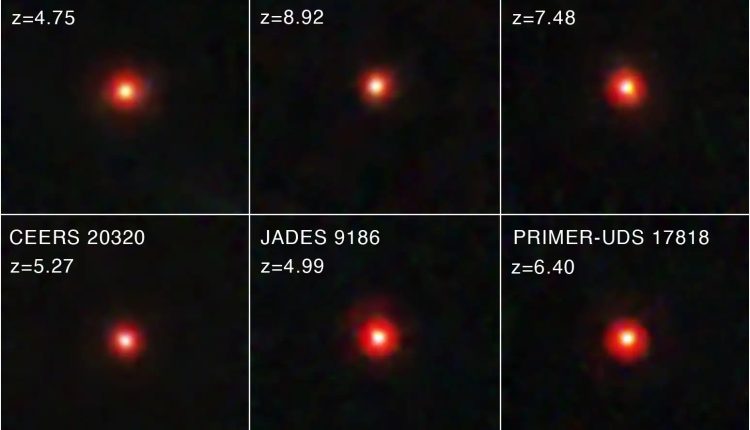They are known as small red dots or LRDs. We find them in Deep -Field pictures of the James Webb Space Telescope (JWST) and you remain a little riddle. However, a new study finds that they are not Super Eddington objects. Although they are unusual, they do not break the known rules of astrophysics.
We are pretty sure that LRD's young super massive black holes are in the hearts of early galaxies. Earlier observations emphatically indicate that they have many properties of active galactic cores (AGNS) such as quasars, blaza and radio alaxies. For example, the emission lines of their spectra are very wide, which means that they come from material that quickly moves by a dense mass. They also do not emit much X-ray or funking, which indicates that the source is surrounded by a dense cloud of ionized gas. This is exactly what you expect from a rapidly growing black hole in an original galaxy.
However, there is a possible catch in this model. Since the light of Agns comes from the superhot acceleration disc around the black hole, the amount of X-rays that you emit is enormous. In order to block the X -rays, the ionized cloud that surrounds the AGN would have to be very thick and almost galactic. This cloud should also block a large part of the visible and infrarotten light that we see from small red dots. To be bright as we observe, these things would have to give up an incredible amount of energy. Maybe too much energy according to what is known as that [Eddington Limit]. (https://briankoberlein.com/post/take-it-to-the-limit/)
To consume matter, black holes have to move gas and dust into the small area that surrounds the black hole. The entire material that tries to enter the black hole is enormously pressed, which is why it overheats and outputs light. Of course, the heat and pressure from the matter push other things away from the black hole. As a result, there is a kind of self-regulating maximum growth rate for black holes, which are referred to as the Eddington limit. If a black hole captures too much matter too quickly, the resulting heat and the resulting pressure would push away in incoming material, causing the growth rate.
It is possible that a black hole will break this border for a short time and become a black hole from Super-Eddington. Eat very quickly and then clear the room with a hot smell. This could also explain the lack of intensive X -rays, since the black hole eats material for X -rays too quickly to build intensity. However, a new study suggests that this is not the case.
X -rays can be difficult to recognize, and we only see a handful of X -ray photons of a certain LRD. The team compiled observations from the Chandra Deep Field South and combined observations of 55 different LRDs into a simulated individual. This gave the team the opportunity to look at the optical depth of the surrounding material statistically and the overall intensity of a typical LRD. What they found was that the amount of ionized gas that an LRD surrounds is considerable, but the overall intensity does not break the Eddington border.
One way to explain these results is to take over that the super massive black holes in the center of small red dots are not as massive as they appear at the beginning. Therefore, in wavelengths that are not strongly covered, without the type of energy -facing X -rays that we observe in more modern AGNs, would output a lot of light. There is still a lot to learn about LRDS, but we now know that they are not as mysterious as we thought.
Reference: Sacchi, Andrea and Akos Bogdan. “Chandra excludes the Super Eddington acceleration for small red dots.” Arxiv Preprint Arxiv: 2505.09669 (2025).


Comments are closed.